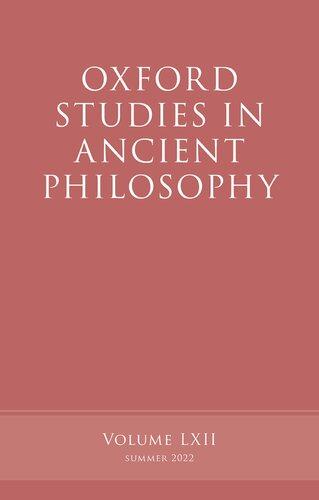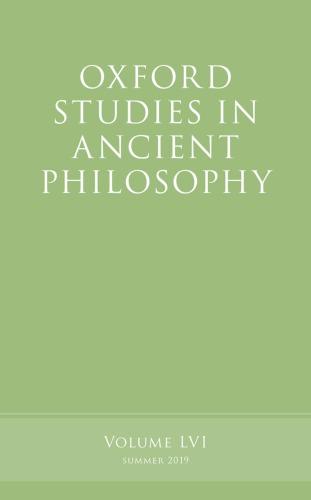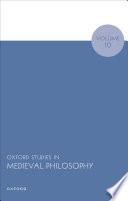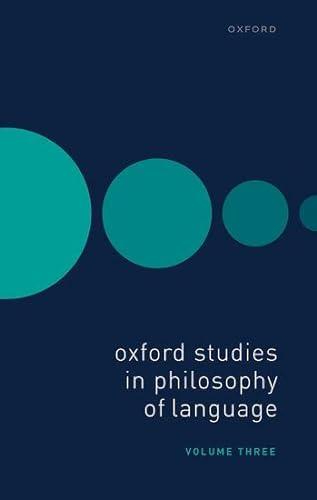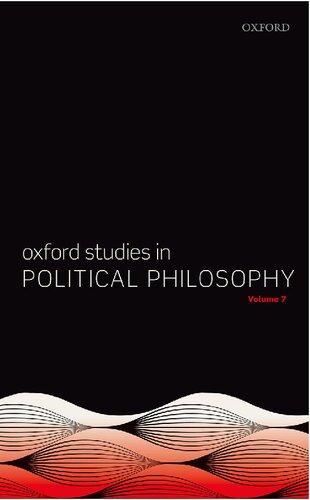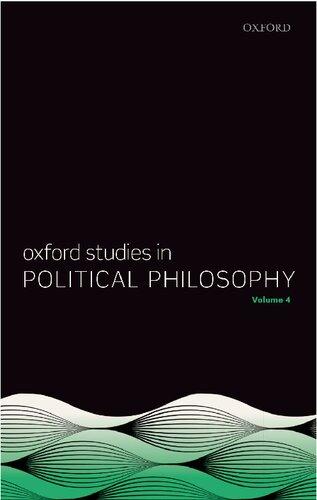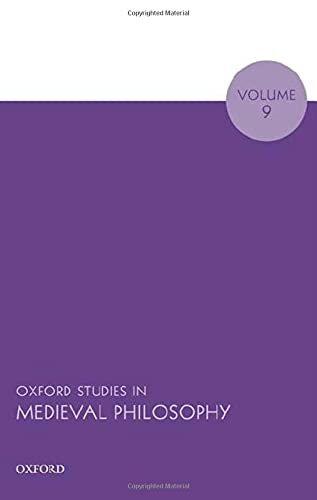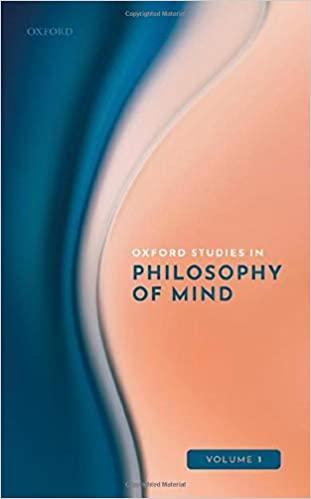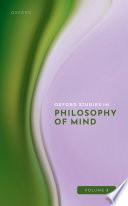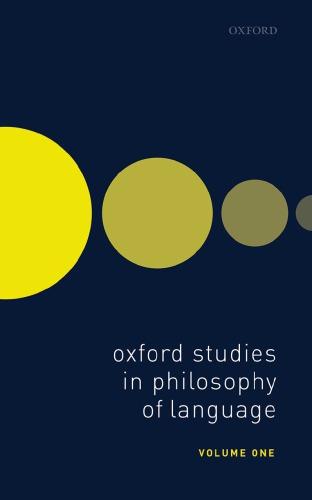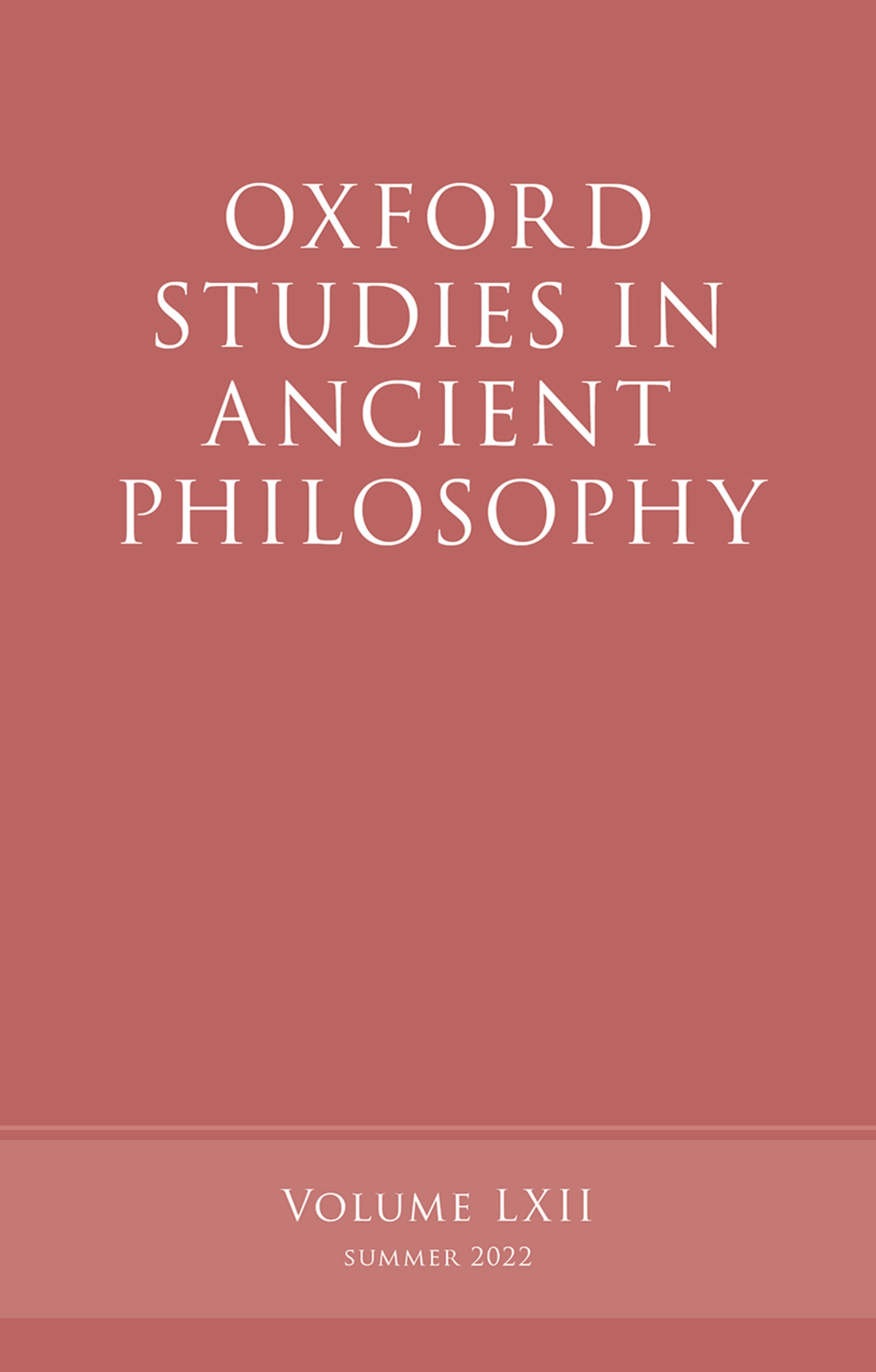IN HERACLITUS
richard neels
1. Introduction
Heraclitus was clearly interested in opposites.1 He was also interested in explaining the cosmos and its constituents.2 In fragment B 1 he promises to explain the nature of each thing (ἐγὼ διηγεῦμαι,
I would like to thank Keith Begley, Victor Caston, Patricia Curd, Tom Davies, Daniel Graham, Mahadi Hassan, David Hitchcock, Tyler Hopkins, Mark Johnstone, Howard Jones, Melle van Duijn, and an anonymous referee for Oxford Studies in Ancient Philosophy for their helpful comments on various drafts of this paper.
1 Heraclitus was famous in antiquity for claiming that opposites were identical See Aristotle, who claims that Heraclitus—or at least followers of Heraclitus— transgressed the Law of Non-Contradiction by claiming that opposites are identical: Top. 8. 5, 159b30–3; Phys. 1. 2, 185b19–25; Metaph. Γ. 7, 1012a24–b22. It should be noted that Aristotle calls this the ‘Heraclitean account’ (τὸν Ἡρακλείτου λόγον) in the Physics passage. Elsewhere he shows sensitivity to the fact that Heraclitus may have meant something different from what he appears to say about the identity of opposites (Metaph. Γ. 3, 1005b23–5). Some modern scholars have also argued that Heraclitus thought that opposites were identical. See K. Popper, ‘Back to the Presocratics’, Proceedings of the Aristotelian Society, 59 (1958), 1–24 at 13; C. Emlyn-Jones, ‘Heraclitus and the Identity of Opposites’, Phronesis, 21(1976), 89–114; J. Barnes, The Presocratic Philosophers (London, 1982), 57. The issue with this view is that none of the extant fragments identifies opposites in such a way that transgresses the Law of Non-Contradiction. The more popular view today seems to be what is known as the Unity of Opposites—or what I call the standard view. See n. 4 below for prominent advocates of this weaker view.
2 By explanation, I mean an account of why something is thus and so. See B. van Fraassen, The Scientific Image (Oxford, 1980), ch. 5, who argues that explanations are answers to why-questions. Heraclitus never poses why-questions specifically, but his fragments are puzzling so as to induce why-questions in his reader. See also R. J. Hankinson, Cause and Explanation in Ancient Greek Thought [Cause and Explanation] (Oxford, 1998), 3–4 for an account of explanation particularly relevant to early Greek philosophy. Finally, see J. Moravcsik, ‘Heraclitean Concepts and Explanations’, in K. Robb (ed.), Language and Thought in Early Greek Philosophy (La Salle, 1983), 134–52. Moravcsik argues that there are three levels of explanation in very early Greek thought: (1) explanation in terms of origin, (2) explanation in terms of constituency, and (3) explanation in terms of a thing and its attributes (134). According to Moravcsik, Heraclitus’ writings represent a shift from the second to the third level of explanation (135). I am in agreement with Moravcsik’s general thesis, though this paper attempts to give much more detail to Heraclitus’ theory and method of explanation.
Richard Neels, Opposites and Explanations in Heraclitus In: Oxford Studies in Ancient Philosophy, Volume LXII (Summer 2022). Edited by: Victor Caston, Oxford University Press. © Richard Neels 2023. DOI: 10.1093/oso/9780192885180.003.0001
κατὰ ϕύσιν διαιρέων ἕκαστον) and to show how things are (ϕράζων
ὅκως ἔχει).3 But how exactly do opposites feature in Heraclitus’ explanation of the cosmos? Most scholars believe that Heraclitus espoused a so-called ‘unity of opposites’ doctrine.4 According to this standard view, Heraclitus claimed that opposites were somehow united and that opposites permeate the world to some extent. So,
3 I have adopted the standard Diels-Kranz number of the fragments found in H. Diels and W. Kranz, Die Fragmente der Vorsokratiker, 6th edn [Fragmente] (Berlin, 1951), but am using the Greek text from D. W. Graham, The Texts of Early Greek Philosophy: The Complete Fragments and Selected Testimonies of the Major Presocratics [Texts] (Cambridge, 2010), where available, and Diels–Kranz otherwise. Translations are also generally from Graham, though I have made significant variations throughout.
4 The view in its modern conception was initiated by G. S. Kirk, Heraclitus: The Cosmic Fragments [Cosmic Fragments] (Cambridge, 1954), esp. at 69. Most scholars since Kirk have followed his view or something very similar to his view. See, for example, G. Vlastos, ‘On Heraclitus’, American Journal of Philology, 76 (1955), 337–68 at 367; G. E. R. Lloyd, Polarity and Analogy (Cambridge, 1966), 96–102; M. Marcovich, Heraclitus: Greek Text with a Short Commentary, 2nd edn [Heraclitus] (Sankt Augustin, 2001), 158–9; M. C. Stokes, One and Many in Presocratic Philosophy (Washington DC, 1971) at 97; A. P. D. Mourelatos, ‘Heraclitus, Parmenides and the Naïve Metaphysics of Things’ [‘Naïve Metaphysics’], in E. N. Lee, A. P. D. Mourelatos, and R. M. Rorty (eds.), Exegesis and Argument: Studies in Greek Philosophy Presented to Gregory Vlastos (Assen, 1973), 16–48 at 33 and 35; C. Kahn, The Art and Thought of Heraclitus [Art and Thought] (Cambridge, 1979), 192; E. Hussey, ‘Epistemology and Meaning in Heraclitus’, in M. Schofield and M. Nussbaum (eds.), Language and Logos: Studies in Ancient Greek Philosophy Presented to G. E. L. Owen [Language and Logos] (Cambridge, 1982), 33–59 at 38; D. Wiggins, ‘Heraclitus’ Conception of Flux, Fire and Material Persistence’, in Schofield and Nussbaum (eds.), Language and Logos, 1–32 at 10; G. S. Kirk, J. E. Raven, and M. Schofield, The Presocratic Philosophers, 2nd edn (Cambridge, 1983), 188–9; T. M. Robinson, Heraclitus: Fragments (Toronto, 1987), 81 and 86; M. M. Mackenzie, ‘Heraclitus and the Art of Paradox’, Oxford Studies in Ancient Philosophy, 6 (1988), 1–37 at 7–8; D. O’Brien, ‘Heraclitus on the Unity of Opposites’, in K. I. Boudouris (ed.) Ionian Philosophy (Athens, 1989), 298–303; P. Curd, ‘Knowledge and Unity in Heraclitus’, Monist, 74 (1991), 531–49 at 539; Hankinson, Cause and Explanation, 29; E. Papamichael-Paspalides, ‘The Concept of One in Heraclitus’, Revue de Philosophie Ancienne, 23 (2005), 41–54 at 42; A. Long, ‘Wisdom in Heraclitus’, Oxford Studies in Ancient Philosophy, 33 (2007), 1–17 at 1–2; J. Warren, Presocratics (Berkley, 2007), 67–70. There are three notable exceptions. For alternative views that break from the standard view, see R. Dilcher, Studies in Heraclitus [Studies] (Hildersheim, 1995), 103–16; C. Osborne, ‘Heraclitus’, in C. C. W. Taylor (ed.), Routledge History of Philosophy, vol. i: From the Beginning to Plato (London, 1997), 80–116 at 92–6; D. W. Graham, ‘Heraclitus’ Criticism of Ionian Philosophy’, Oxford Studies in Ancient Philosophy, 15 (1997), 1–50. Graham expanded and revised his argument in D. W. Graham, Explaining the Cosmos: The Ionian Tradition of Scientific Philosophy [Explaining the Cosmos] (Princeton, 2006.) I will make reference to the expanded and revised version of his argument in this paper. Osborne and Graham in particular make notable advancements in our understanding of Heraclitus’ use of opposites. I discuss these views in Section 2 below.
and Explanations in Heraclitus 3
on this view, Heraclitus was encouraging his readers to comprehend the hidden connectedness of opposites and, perhaps, the connectedness of all things.5 I will argue that the standard view is incomplete. Opposites are indeed connected, and I believe Heraclitus (and his Ionian predecessors) recognized this feature of the world. However, I do not think the demonstration of this fact was his primary goal in composing the opposites fragments. The central issue with the standard view is that any clear formulation of a unity of opposites principle is too restrictive to make complete sense of Heraclitus’ interesting and varied statements about opposites.6
In place of the standard view, I argue that Heraclitus’ treatment of opposites was a reaction to the way opposites were being used by his Ionian predecessors, Anaximander and Anaximenes.7 Opposites, for the earlier Ionians, seem to have been explanatory principles: fundamental explanantia. The physical world, which includes events, stuffs, and things, was explained by a limited set of oppositional pairs (e.g. hot and cold, condensation and rarefaction). Heraclitus’ treatment of opposites, I submit, is best understood in relation to these earlier schemes of philosophical explanation. I will argue that Heraclitus was the first Ionian to treat opposites not as explanatory principles but as philosophical problems in need of explanation. Heraclitus’ opposites are related to his philosophical explanation of the cosmos insofar as they are (a) negatively, explananda in need of explanantia and (b) positively, the clearest expression of the interdependent nature of the metaphysical structure of the cosmos and things in it. Heraclitus appears to have held a principle of non-
5 For example, Kirk writes: ‘The Logos is undoubtedly connected with the opposites, in fact it is the unity which underlies them and which binds together into one nexus all the components of the apparently discrete phenomenal world’ (Cosmic Fragments, 188–9). He also claims that ‘The Logos is the formula, structure, plan, of each and all things As such it results in the fact that “all things are one” because they all connect up with each other because of this common structure’ (70, emphasis original).
6 I defend this claim below in Section 2. See Dilcher, Studies, 103–8 for another critique of the essential connection thesis. He points out that ‘it is equally easy to state this idea of unity-in-opposites and to apply it to any opposition that [we] might encounter, as it is exceedingly difficult to explicate with any reasonable precision in what way these opposites actually “coincide.” The formula cannot be directly elicited from any Heraclitean fragment. The relevant fragments present “opposites” of the most diverse kind and are as varied in their formulation as they could conceivably be’ (104).
7 Anaximander and Anaximenes were residents of the Ionian city of Miletus, while Heraclitus lived in the nearby Ionian city of Ephesus.
well-foundedness, according to which there are no metaphysically foundational entities, and to a principle of reciprocal determination, whereby the cosmos and its parts are caught in a web of explanatory interdependence. In the end, the opposites too are part of this web of metaphysical interdependence and, as such, are both explananda and (non-fundamental) explanantia in the cosmos.
2. Preliminaries on explanation and opposites
Fragment B 1 is taken by most to have been the opening of Heraclitus’ book. It will prove a helpful place to begin understanding what Heraclitus thought about explanation:
B 1 DK)
Of this logos which holds always, humans prove to be uncomprehending, both before they hear it and after hearing it for the first time. For although all things come to be in accordance with this logos, they are like the inexperienced experiencing words and deeds such as I explain when I distinguish each thing according to its nature and show how it is. Other humans are unaware of what they do when they are awake just as they are forgetful of what they do when they are asleep.8
Perhaps the most striking feature of this fragment is Heraclitus’ novel use of the Greek term logos.9 Prior to Heraclitus, the term logos was used to indicate a structured account of events.10 Heraclitus claims that ‘all things’ (πάντα) come to be in accordance with the
8 This fragment is preserved for us by both Sextus Empiricus (M 7. 132–3) and Hippolytus (Haer. 9. 9. 3). Both Aristotle (Rhet. 3. 5, 1407b14–15) and Sextus claim that B 1 is the opening of Heraclitus’ book.
9 Most interpreters have supposed that the term refers to some cosmic principle. For example, see Kirk, Cosmic Fragments, 39. This has been challenged by some who claim that it simply refers to Heraclitus’ account (i.e. his book). The most notable proponent of this view is perhaps M. L. West, Early Greek Philosophy and the Orient [Orient] (Oxford, 1971), 124–9. For my part, I agree with M. Johnstone, who argues for a middle position. See M. Johnstone, ‘On “Logos” in Heraclitus’ [‘Logos’], Oxford Studies in Ancient Philosophy, 47 (2014), 1–29. I deal with the philosophical significance directly in Section 5 below.
10 See Johnstone, ‘Logos’, 13–17.
Opposites and Explanations in Heraclitus 5 logos of which he speaks. Furthermore, the logos holds always (ἐόντος αἰεί ). At the very outset, Heraclitus seems to commit himself to a cosmos that has a stable structure.11 Furthermore, he seems optimistic that the stable structure of the cosmos renders the cosmos intelligible and explicable, even though he seems to think this is a very difficult task.
Let’s examine some of the verbs contained in this fragment. Heraclitus claims to ‘explain’ (διηγεῦμαι) things. (I gloss ἕκαστον as ‘things’, since the ‘each’ refers to the ‘all things’ (πάντα) earlier in the fragment.) διηγεῦμαι has the sense of describing something in detail to someone who isn’t in the know.12 He also claims to show how things are (ϕράζων ὅκως ἔχει). ϕράζειν has the sense of showing or telling someone a piece of information.13 It was often used prior to Heraclitus in the sense of showing or telling someone the way to get somewhere.14 It was also used in the sense of relaying a command from a place of authority.15 Hence the term connotes the passing on of reliable, practical information from a source of authority. Finally, Heraclitus promises to differentiate (διαιρέω) things according to their nature (κατὰ ϕύσιν). διαιρέω has the sense of division or taking things apart.16 Heraclitus’ term for nature or phusis seems to mean something like a thing’s metaphysical character.17 The main
11 Of course, this has been the subject of great controversy. However, I believe it is safe to say that most scholars today doubt Heraclitus held a theory of radical flux whereby everything is always changing in every respect. See Graham, Explaining the Cosmos, 113–22 for a summary of the debate over the last century. I take it that the standard view today regarding flux is that Heraclitus’ cosmos does change but that the change is orderly and the order is stable. In Heraclitus’ own words: ‘Changing, it rests’ (μεταβάλλον ἀναπαύεται, B 84a). See Graham, Explaining the Cosmos, 129–37 for an account of flux in Heraclitus’ stable world.
12 For later uses of the term see Ar., Birds 198 and Antiph., Against the Stepmother, 13.8. See also Kirk, Cosmic Fragments, 41, who implies that the term for Heraclitus means ‘explanation’ in a strong sense of the term.
13 E. Cunliffe, A Lexicon of the Homeric Dialect (Norman, 2012) includes ‘display’, ‘indicate’, ‘instruct’, and ‘direct’ as translations of this term.
14 See Hom., Od. 11. 2 and 14. 3.
15 See Hom., Il. 10. 127 and Od. 10. 549.
16 Kirk claims that this term ‘means something more than merely “judging”, and implies a process of analysis’ (Cosmic Fragments, 41). This is, of course, a precursor to the great notion of diairesis in Plato and Aristotle. See Plato, Soph. 253 d 1–3 and Arist., Pr. An. 1. 31.
17 Phusis prior to Heraclitus meant something like ‘visible characteristic’. See Hom., Od. 10. 302–6. Pindar, writing around the same time as Heraclitus, also used the term ‘phusis’ to reference visible characteristics. See Pind., Isthm. 4. 50. However, Heraclitus elsewhere claims that ‘a nature tends to be hidden’ (
Richard Neels
verb of the clause is ‘explain’ (διηγεῦμαι) and Heraclitus uses the participle ‘differentiating’ (διαιρέων) most plausibly to indicate his means of explanation. If this is right, Heraclitus is interested in explaining things according to their nature by differentiating them. These words apply to ‘all things’ (πάντα) referenced earlier in the fragment. So, it seems safe to say that Heraclitus was interested in explaining the way things are. But I do not think he was merely interested in cataloguing and describing the existents of the world. Elsewhere, in B 50, he claims that ‘all things are one’ (ἓν πάντα εἶναι, with Diels). Significantly, Heraclitus calls the world ‘kosmos’ in the sense of an ordered whole.18 All this strongly suggests that Heraclitus saw himself as explaining the structure and nature of all things (πάντα) which constitute the cosmos (κόσμος).
It is difficult to know exactly what Heraclitus took to constitute the class of ‘things’. We might think it is all ‘things’ in a robust sense whereby things are the bearers of properties. But I think this is too strong for a Presocratic thinker writing before the incredibly nuanced discussions of Plato and Aristotle. Instead, I propose we treat ‘all things’ (πάντα) as referring to all the aspects of the cosmos: things, properties, stuffs, and events. At any rate, these are what he discusses in his fragments. All these aspects of the cosmos have a
B 123). I take this to indicate Heraclitus has metaphysical character (i.e. something closer to an essence) in mind rather and not just a loose description of visible characteristics. See A. P. D. Mourelatos, The Route of Parmenides, revised and expanded edn (Las Vegas, 2008), who states that ‘The term clearly carries for [Heraclitus] a sense of real constitution or inner nature’ (6). See also K. Begley, ‘Heraclitus against the Naïve Paratactic of Mere Things’, Ancient Philosophy Today, 3 (2021), 74–97, for an interpretation of Heraclitus according to which his interest in phusis is in terms of essences. For a more thorough analysis of the term ‘phusis’, see my ‘Phusis, Opposites and Ontological Dependence in Heraclitus’ [‘Phusis’], History of Philosophy Quarterly, 35 (2018), 199–217 at 200–3.
18 See C. Kahn, ‘Anaximander’s Fragment: The Universe Governed by Law’, in A. P. D. Mourelatos (ed.), The Pre-Socratics: A Collection of Critical Essays (Princeton, 1993; originally published, 1974), 99–117. He states: ‘Precisely considered, the kosmos is a concrete arrangement of all things, defined not only by a spatial disposition of parts, but also by the temporal taxis within which opposing powers have their turn in office’ (111). In B 30 Heraclitus refers to the world as κόσμον τόνδε This is the first known philosophical use of the word κόσμος (although it is possible it was used before Heraclitus). See also G. Betegh and V. Piano, ‘Column IV of the Derveni Papyrus: A New Analysis of the Text and the Quotation of Heraclitus’, in C. Vassallo (ed.), Presocratics and Papyrological Tradition (Berlin, 2019), 179–220 at 198–200.
Opposites and Explanations in Heraclitus 7
character—a nature or phusis—and Heraclitus seems interested in explaining how all these aspects hang together as an orderly whole. B 1 has an analytic flavour. Heraclitus promises to break down ( διαιρέω ) the cosmos into smaller components in order to reveal the nature of its parts (ἕκαστον). This may give us the sense that Heraclitus intends to explain the cosmos by division. However, this is only partially true. If we turn to the extant fragments, we will see that Heraclitus spends as much time synthesizing discrete parts of the cosmos as he does analysing the cosmos into its parts. Some of the most famous fragments speak to Heraclitus’ synthetic project. B 50 claims that ‘all things are one’ (ἓν πάντα εἶναι, with Diels) and B 41 claims that ‘thought . . . steers all things through all things’ (γνώμην . . . ἐκυβέρνησε
). I think B 10 provides a clear statement of Heraclitus’ balanced interest in synthesis and analysis:
. (22 B 10 DK)
Collectives: wholes and not wholes; brought together, pulled apart; sung in unison, sung in conflict; both from all things one and from one all things.19
The point, I think, is that Heraclitus saw himself explaining the way the cosmos is and why it is that way. I will have a great deal more to say about the details of Heraclitus’ scheme of explanation below. For now, let it suffice that he seems to have thought that he needed to analyse the cosmos into its parts and synthesize its parts into a whole in order to explain the cosmos and its parts.
But now let’s turn to the opposites so we can begin to inquire into their relation to Heraclitus’ scheme of explanation. To begin, it will prove useful to examine just a few of the opposites fragments in brief.20 Much more can and has been said concerning the following fragments. I will simply focus on features relevant to our question. My initial goal here is twofold: (1) to provide a glimpse
19 I discuss this fragment in much more detail in Section 5 below.
20 See the ‘Table of Opposites in Heraclitus’ Doctrine on the Logos’, in Marcovich, Heraclitus, inserted between pages 160–1, for a useful introductory guide to the opposing terms in Heraclitus. For each pair of opposites, Marcovich lists their ‘Reason for Unity’. But in the end, he finds eleven different reasons for the unity of various opposites. Marcovich does not attempt to explain how the eleven different reasons are related to one another. I take this as evidence that Marcovich has not given a full explanation of Heraclitus’ use of opposites.
of the richness and variety of the fragments concerned with opposites and (2) to show that the standard view—that Heraclitus is merely displaying the internal connection of opposites—is unable to account for that variety and richness. If this is true, then the standard view cannot account for how the opposites feature in Heraclitus’ explanation of the cosmos. I don’t mean to suggest that the standard view is incompatible with these fragments, but just that it fails to bring out what is most interesting about opposites and indeed what seems to be Heraclitus’ point in repeatedly referring to them.
First, consider fragment B 57:
(22 B 57 DK)
The teacher of the multitude is Hesiod; they believe he has the greatest knowledge—who did not comprehend day and night: for they are one.21
I begin with this fragment because it is, perhaps, the strongest evidence for the standard view. As is well known, Hesiod treated the divinities Day and Night as distinct entities.22 Heraclitus appears to be correcting this by claiming that they are one, that is, day and night are opposing parts of a single meteorological process. The deeper point seems to be this: what-it-is-to-be-day and what-it-isto-be-night are connected by being conceptually interdependent— they belong to a single conceptual sequence. So, it does appear that Heraclitus recognized that opposites were connected. But it does not follow that this was a new discovery on Heraclitus’ part,23 nor does it follow that this was Heraclitus’ only or even primary interest in opposites. The interpretive strategy of the standard view has been to take this somewhat clear expression of a principle and read it onto all the other instances of Heraclitus’ opposites. But we shall
21 Dilcher, Studies, 109 takes an even stronger stance against the standard view. He argues that the ἕν cannot refer to day and night since day and night are feminine nouns and ἕν is neuter. Dilcher thinks this is good evidence against any notion of unity of opposites in Heraclitus. But this might be wrong, since it is possible, at least in slightly later Greek prose, for a neuter noun to refer to two feminine ones. Compare e.g. the use of the neuter ταὐτόν at Arist., Pol. 1. 7, 1255b16–17 (οὐ ταὐτόν ἐστι δεσποτεία καὶ πολιτική Ross).
22 See Mourelatos, ‘Naïve Metaphysics’, 33–4.
23 I think it is implausible that Anaximenes, for example, could use rarefaction and condensation as he does without realizing that the two processes are conceptually connected.
Opposites and Explanations in Heraclitus 9
see just how restrictive this move is when we examine other instances of Heraclitus’ opposites in their own right.
Consider fragment B 61:
θάλασσα
. (22 B 61 DK)
Sea is the purest and most polluted water: for fish drinkable and healthy, for men undrinkable and harmful.24
On the surface, Heraclitus is making the true observation that seawater is both pure and polluted. This is a judgement of value: seawater is both good and bad. But Heraclitus is obviously not supposing that seawater is both A and not-A at the same time and in the same respect. He specifies that seawater has these properties relative to different species. For fish, it is good to drink, but for humans, it is not good to drink. The deep meaning of the fragment seems to indicate something about value: opposing values are dependent on different kinds of subjects.25 This is an interesting and important philosophical insight concerning opposites and values. Now, according to the standard view, the meaning of the fragment must merely be that these opposites, as with all opposites, are connected; so, this fragment shows that purity and pollution are connected. But this seems to miss the deep insight concerning kind-relative value, an insight that has to do with opposites but that cannot be cashed out in terms of the standard view. Here is another fragment concerning opposites:
. (22 B 51 DK)
They do not understand how disagreeing with itself it agrees with itself: reciprocal structure as of a bow or a lyre.26
24 This fragment is also preserved by Hippolytus (Haer. 9. 10. 5). Hippolytus claims ‘[Heraclitus] says that the polluted and the pure are one and the same thing and that the drinkable and the undrinkable are one and the same thing’ (καὶ
25 This thought resurfaces in a few other fragments: B 9, B 13, B 11. For a further discussion of this insight concerning value, see Neels, ‘Heraclitus on the Nature of Goodness’, Ancient Philosophy, 41 (2021), 1–22.
26 This fragment is preserved for us by Hippolytus (Haer. 9. 9. 2). There is some disagreement over the word παλίντροπος; some scholars prefer παλίντονος (i.e. backstretched), since the term was known in ancient times as a Homeric epithet for ‘bow’ (τόξον). Furthermore, Plutarch, who cites the fragment three times, once renders it παλίντονος. Marcovich, Heraclitus, and Kirk, Cosmic Fragments, support παλίντονος,
Richard Neels
The opposites cited in this fragment are disagreement and agreement, and the claim is that something can agree with itself while disagreeing with itself. This principle is applied to a bow and a lyre as illustrative examples of the principle. It is clear to see how a bow and a lyre disagree while agreeing with themselves. Take a bow. The stave and string are at odds with one another in that they exert opposing forces on one another. However, the bow agrees with itself in that these opposing parts constitute the very nature of the bow. So, at least for some objects, the opposites present in them are constitutive of the very nature of the objects in question. But again, the standard view must conclude that this fragment is merely saying that disagreement and agreement are connected. Again, this misses a rich philosophical insight about opposites and their role in constituting the nature of various objects.27
Finally, consider the following fragments together:
. (22 B 126 DK)
Cold things warm up, hot things cool off, wet things become dry, dry things become moist.28
. (22 B 76 b–c DK)
The death of fire is the birth of air, and the death of air the birth of water. It is death for earth to become water, and death for water to become air, and death for air to become fire and contrariwise.29
B 126 contains a true observation about changing opposites: cold and hot, wet and dry are connected in terms of change. B 76 contains a set of elemental transformations. I believe the two fragments resonate thematically. The opposites listed in B 126 happen to be what later Greeks associated with the four elements listed in
while Kahn, Art and Thought, and Graham, Texts, support παλίντροπος. For my part, I am happy to leave the text as it has been handed down to us as παλίντροπος.
27 See Neels, ‘Phusis’, for more details on other fragments that seem to illustrate the same insight concerning opposing properties and their role in constituting objects. Importantly, rivers (B 12) seem to bear this oppositional structure.
28 This fragment is preserved by Tzetz., Scholia ad exeg. in Iliadem, 126 Hermann.
29 Diels, Fragmente, provides three variants of this fragment together. I have provided a combination of the second (from Plutarch) and third (from Marcus Aurelius). Graham, Texts, places these two together, but they may very well have been disparate quotations. I think it is helpful to see the two together, but I do not think my philosophical point rests on this precise composition.
and Explanations in Heraclitus 11
B 76.30 The fragments, if they do go together, suggest that the elemental stuffs which constitute material reality change and in virtue of this change things become warm or cool, wet or dry.31 This, again, is a deep philosophical insight about reality. But on the standard view, B 126 merely indicates that cold and hot, wet and dry are connected and B 76 merely indicates that death and birth are connected. While it is true that these opposites are connected, the interpretive strategy of the standard view misses the rich connection between elemental transformations and the changes between opposing properties. I don’t mean to suggest that scholars who accept the standard view can’t also recognize these various insights; however, the standard view does not explain how Heraclitus’ concern about the unity of opposites relates to his other concerns about opposites.
There are two alternatives to the standard view that are worth considering. Catherine Osborne has argued that for Heraclitus ‘[i]dentity, similarity, difference, opposition’ are ‘all determined by the significance acquired in context’.32 She states that, according to Heraclitus, ‘what counts as the same and what counts as opposed is decided by a significance acquired in a social or temporal context, and is not determined absolutely by a fixed or material constitution in the entities we observe’.33 This view goes a long way towards breaking from the standard view. It is particularly good at explaining fragments like B 61 concerning seawater. However, it does not seem to be able to make good sense of a fragment like B 51 concerning the bow and the lyre. The opposition inherent in and the resulting identity of the bow and the lyre do not seem to be context dependent, and they do, in fact, seem to have a fixed constitution: without certain material conditions, the bow and the lyre fail to be what they are. Furthermore, oppositions qua opposites don’t seem to be determined by context: hot and cold may be relative to
30 This is most clearly seen in Arist., GC 2. 3.
31 See my discussion of Daniel Graham’s view later in this section. See also G. Betegh, ‘On the Physical Aspect of Heraclitus’ Psychology’ [‘Physical Aspect’], Phronesis, 52 (2007), 3–32, who incorporates Heraclitus’ soul into the physical flux of elements. On Betegh’s view too, there is an association between the elements and the elemental properties, including mental properties. There may be some disagreement about the precise relations of the properties to the elements, but that there is a relation seems to be agreed on by most scholars.
32 Osborne, ‘Heraclitus’, 94.
33 Osborne, ‘Heraclitus’, 80.
context, but qua opposites they seem to be relative merely to one another. While I think Osborne captures something Heraclitean and while her interpretation does much better than the standard view in accounting for deep philosophical insight, it cannot fully account for the variety of opposites. As such, it fails to provide a satisfying solution to the relation between Heraclitus’ opposites and his philosophical explanation of the cosmos.
Daniel Graham presents another alternative to the standard view: opposites are the same just in the sense that opposite things or stuffs turn into one another They are, moreover, quantitatively equivalent in the sense described, by bearing a determinate ratio to one another. To say that opposites are the same is simply to say that they are transformationally equivalent.34
Graham’s interpretation of Heraclitus’ use of opposites works well with fragments like B 126 and B 76. But Graham’s thesis cannot make sense of the opposing values of seawater in B 61 or of the opposing forces of the bow and the lyre in B 51. These fragments cite opposites that have nothing to do with transformation. Graham doesn’t force a false thesis on Heraclitus, but as with Osborne, the interpretation does not account for the variety of opposites.
Heraclitus’ opposites clearly have something to do with his explanation of the cosmos. I have argued that there are multiple philosophical insights concerning opposites in the world. The insights do not seem to be reducible to the single thesis ‘opposites are essentially connected’. So, we are left with two problems: how exactly do Heraclitus’ opposites feature in Heraclitus’ explanation of the cosmos? And what unifies Heraclitus’ interest in opposites? To answer these questions, I believe it is helpful to examine how opposites were used in philosophical explanations prior to Heraclitus.
3. Opposites in Heraclitus’ predecessors
Heraclitus was preceded by two other Ionian thinkers: Anaximander and Anaximenes. Both thinkers appealed to opposites in their explanations of the cosmos. In what follows, I present a sketch of
34 Graham, Explaining the Cosmos, 129.
Anaximander’s and Anaximenes’ ideas, which I take to be, for the most part, uncontroversial.
According to Anaximander, there is something called the apeiron, which seems to be a sort of primordial entity from which all things are generated. Aristotle claims that the apeiron is Anaximander’s arche his starting point of metaphysical explanation.35 Anaximander seems to have constructed a cosmogony based on the apeiron:
. (12 A 10. 7–10 DK)
[Anaximander] says that the part of the everlasting [i.e. the apeiron] which is generative [γόνιμον] of hot and cold separated off [ἀποκριθῆναι] at the coming to be of the world order and from this [ἐκ τούτου] a sort of sphere of flame grew around the air about the earth like bark around a tree.36
It is hard to know with certainty, but it seems that this bit of testimonia is evidence that there are two stages of cosmic generation. First, a ‘generative part’ (γόνιμον) of the apeiron separates off from the apeiron itself. Second, this mysterious part of the apeiron produces physical contrarieties (hot and cold) as well as physical stuffs (fire, air, and earth).37 It seems that Anaximander’s entire cosmos is explained by these physical stuffs and their opposing properties. From Theophrastus (quoted by Simplicius), we learn that from the apeiron things come to be, but also that it is into the apeiron that things perish. Consider Anaximander B 1, which is embedded in a paraphrase from Simplicius:
.
35 By ‘metaphysical explanation’ I mean an explanation for why things are thus and so. Note that metaphysical explanations do not preclude anything physical. See Arist., Phys. 3. 4, 203b6–28. Simplicius claims that Anaximander is the first to introduce the term apeiron as an arche (In Phys. 24. 13–16 Diels). We don’t know for certain whether Anaximander himself used the term arche, but Aristotle is right to point out that the apeiron is a metaphysical principle in the sense that it is the metaphysical ground for everything.
36 A 10 DK is a testimony from pseudo-Plutarch, Strom. 2. Though it is, on the whole, clearly a testimony and not a verbatim quotation, Graham, Texts, thinks the words italicized are verbatim quotations.
37 Simplicius tells us that ‘[Anaximander’s] contrarieties are hot, cold, dry, moist, and the others’ (ἐναντιότητες
, In Phys. 150. 24–5 Diels). It isn’t clear here what Simplicius means by ‘the others’.
From what things existing objects come to be, into them too does their destruction take place, according to necessity: for they give recompense and pay restitution to each other for their injustice according to the ordering of time, expressing it in these rather poetic terms.38
According to the standard interpretation of Anaximander, the most basic entities are the elemental powers, which participate in a system of retaliation with one another, such that if one opposite becomes too powerful, it is overtaken by another opposite. According to Aëtius, Anaximander thought that meteorological events are consequences of wind (A 23). But we also learn that wind is accounted for by elemental powers in strife: ‘Anaximander [says] wind is a rush of air when the most fine and moist parts of it are moved or dissolved by the sun’ (
, A 24). Presumably the sun has the power to heat and thereby dry out the moisture in the air, causing the air to move and become wind. Wind accounts for the meteorological phenomena, but the striving of opposing powers accounts for wind. If this is correct, Anaximander seems to have treated the opposites as fundamental explanantia with reference to the rest of the physical world.39 Graham writes: ‘In Anaximander we see a closed system of explanation, in which a set of items, apparently including elemental stuffs and their contrary properties, accounts for all the phenomena of experience.’40 Since the opposites seem to pose the ultimate physical explanation of the physical stuffs and their operations, I believe it makes most sense to suppose that for Anaximander the war of opposites is the most basic principle of explanation for this world. The apeiron
38 The italicized words are generally thought by scholars to be original to Anaximander.
39 C. Kahn supports this view (Anaximander and the Origins of Greek Cosmology [Anaximander] (New York, 1960), 178). Vlastos too seems to suggest this when he speaks of ‘the opposites which constitute this world’ (‘Equality and Justice in Early Greek Cosmologies’ [‘Equality and Justice’], Classical Philology, 42 (1947), 156–78 at 169). G. Freudenthal claims that the statement ‘the basic constituents of Anaximander’s world are equal opposite powers’ is ‘uncontroversial’ (‘The Theory of Opposites in an Ordered Universe: Physics and Metaphysics in Anaximander’ [‘Theory of Opposites’], Phronesis, 31 (1986), 197–228 at 198). Graham, on the other hand, argues against this pure power ontology (Explaining the Cosmos, 42). But he still promotes, as do I, the interpretation that the powers are the explanatorily basic factors in Anaximander’s thought.
40 Graham, Explaining the Cosmos, 42.
Opposites and Explanations in Heraclitus 15 may explain why the opposites and their stuffs exist at all,41 but it is the opposites that provide the ultimate explanation why stuffs are the way they are and behave the way they do.42
I turn now to Anaximenes, who is generally thought to be one of Anaximander’s rough contemporaries.43 According to the testimonia, Anaximenes provides an explanation of the physical world by means of two opposing processes, rarefaction and condensation:
. (13 A 5. 3–6 DK)
[Air] differs in essence in accordance with its rarity (μανότητι) and density (πυκνότητι). When it is thinned (ἀραιούμενον), it becomes fire, while when it is condensed, it becomes wind, then cloud, when still more condensed, it becomes water, then earth, then stones. Everything else comes from these.44
Here, as with Anaximander, Anaximenes in a way treats opposites as the fundamental explanantia of the physical world. It is true that Aristotle claims Anaximenes’ arche is air, but the real explanatory power seems to come from the opposing processes that account for the differences in essence of the various stuffs into which air can transform.45 This is not to say that the opposites are of the same sort for Anaximenes and Anaximander or that they account for the physical world in the same way. For Anaximander, it seems opposing powers explain the physical world, while for Anaximenes opposing processes explain the physical world. But it does seem that both attempted to offer an explanation of the cosmos by appealing to fundamental opposites. To put it simply, for both Anaximander and Anaximenes, stuffs, things, and events in the physical world are explananda and certain opposites serve as their explanantia.
41 This interpretation of the apeiron is supported by Vlastos, ‘Equality and Justice’, but contested by Freudenthal, ‘Theory of Opposites’.
42 Some may think that cosmic justice is a fundamental, explanatory principle for Anaximander. However, it seems to me that Anaximander’s opposites are selfregulating as a matter of necessity. Cosmic justice simply is the self-regulating war of opposites.
43 Diogenes Laertius (2.3) and Simplicius (In Phys. 24. 26 Diels) claim that Anaximenes was the student of Anaximander. But these later reporters loved to arrange all historical philosophers into long chains of teachers and students, often without any real evidence.
44 This testimony is provided by Simpl., In Phys. 24. 26–25. 1 Diels.
45 Arist., Metaph. Α. 3, 984a5–7.
Richard Neels
Anaximander and Anaximenes seem to be concerned with explanatory fundamentality . 46 Their respective opposites appear to be fundamental explanantia for the rest of the physical world. As such, we can classify their views in line with Metaphysical Foundationalism. According to foundationalists, the entire cosmos is explained by one or more metaphysically foundational (i.e. absolutely fundamental) entities.47 Explanations flow in one direction from the foundational entity/entities through the varying levels of
46 In the terms of modern metaphysics, we might say they are concerned with grounding. Grounding relations are generally thought to be ‘in virtue of’ relations, such that when y holds in virtue of x, x grounds y. If x grounds y, then x is more fundamental than y and x explains y. While these early thinkers are clearly not concerned with the finer points of grounding relations being debated today, their systems of explanation seem to follow the general pattern of grounding as expressed above. See F. Correia and B. Schnieder (eds.), Metaphysical Grounding: Understanding the Structure of Reality [Metaphysical Grounding] (Cambridge, 2012) for a recent anthology on ground. There is a current debate concerning the precise nature of ground; for a sample of this debate, see G. Rosen, ‘Metaphysical Dependence: Grounding and Reduction’, in B. Hale and A. Hoffman (eds.), Modality: Metaphysics, Logic, and Epistemology (Oxford, 2010), 347–83; C. S. Jenkins, ‘Is Metaphysical Grounding Irreflexive?’, Monist, 94 (2011), 267–76; J. Schaffer, ‘Grounding, Transitivity, and Contrastivity’, in Correia and Schnieder (eds.), Metaphysical Grounding, 122–38. K. Fine, ‘Guide to Ground’ [‘Guide’], in Correia and Schnieder (eds.), Metaphysical Grounding, 37–80; K. Koslicki, ‘Varieties of Ontological Dependence’, in Correia and Schnieder (eds.), Metaphysical Grounding, 186–213; M. J. Raven, ‘Ground’, Philosophy Compass, 10 (2015), 322–33; J. Zylstra, ‘The Essence of Grounding’[‘Essence’], Synthese , 196 (2019), 5137–52. The notion of grounding I believe to be at work in Anaximander is endorsed by Raven, ‘Ground’. According to Raven, ‘Ground is supposed to serve a certain job description: it is the common factor in diverse in virtue of questions, the structuring relation in the project of explaining how some phenomena are “built” from more fundamental phenomena, and a key part of a venerable tradition concerned with metaphysical explanation’ (324, emphasis original). He also explains that ‘ground is metaphysical because it concerns the phenomena in the world itself, but also explanatory because it concerns how some phenomena hold in virtue of others’ (326, emphasis original). We might worry that it is anachronistic to interpret these thinkers as being concerned with grounding. However, the idea is not that they are consciously employing a concept of grounding, but merely that they seem to have had some basic notion of ontological and explanatory fundamentality, and that this notion, untheorized among these early Greek philosophers, is the same one contemporary metaphysicians interested in grounding investigate.
47 Raven, ‘Ground’, summarizes foundationalism: ‘if explanations must begin, then so too any grounded fact must ultimately be grounded in facts which themselves are ungrounded [this] entails that this ordering terminates in minimal elements, like an explanatory chain beginning from unexplained explainers’ (327). These unexplained explainers are foundational entities.
Opposites and Explanations in Heraclitus 17 fundamental entities to the derivative entities.48 Anaximander’s metaphysical foundation or arche is the apeiron, and Anaximenes’ is air insofar as these pose the existential conditions for the cosmos. These, in turn, ground the existence of the opposites, and, in the words of Simplicius, ‘everything else comes from these’ (τὰ δὲ ἄλλα ἐκ τούτων). The opposites are existentially derivative from the foundation, but the opposites are fundamental to the rest of the physical world (observable stuffs, things, and events). In short, their respective opposites do all the explanatory work with respect to the nature of the physical world. In sum, Anaximander and Anaximenes accepted two principles concerning opposites and explanations: (1) the physical stuffs, things, and events in the world are explananda, and certain opposites are their explanantia, and (2) these opposites are explanatorily fundamental in the physical world, and everything else in the physical world is explained with reference to them.49
4. Opposites as explananda
When we turn to Heraclitus, we see a change in how opposites are featured, but it is difficult to see clearly what that change amounts to.50 In Anaximander and Anaximenes, the featured opposites are
48 A contemporary expression of this principle is called a Strict Partial Order: explanatory relations are irreflexive, transitive, and asymmetric. See M. J. Raven, ‘Is Ground a Strict Partial Order?’, American Philosophical Quarterly, 50 (2013), 193–201. Anaximander’s and Anaximenes’ explanations do appear to follow a Strict Partial Order. According to this view, chains of grounding obtain. In the grounding chain, X → Y → Z, X is foundational and non-derivative; Y and Z are derivative, though Z is more derivative than Y; and Y is fundamental with respect to Z, but derivative with respect to X
49 This isn’t to say that Anaximander and Anaximenes don’t have their differences with respect to their schemes of explanation, but I do think it is safe to say that they held these principles in common. It’s worth pointing out that this interpretation fits nicely with Aristotle’s argument that the ‘physicists’ used contraries to explain change in the cosmos (Phys. 1. 5, 188a27–31).
50 Lloyd, Polarity and Analogy, tries to make sense of Heraclitus’ new approach within the tradition of appealing to opposites: ‘while Heraclitus’ theory was exceptional in that he particularly emphasised the interdependence or “unity” of opposites, it was typical in so far as he too analysed the data of experience generally into pairs of opposites’ (17). However, Lloyd does not discuss exactly how and why Heraclitus analysed the data of experience into opposites. Furthermore, it seems Heraclitus treated the pairs of opposites as data of experience rather than analysing the data of experience by means of opposites (esp. B 126: ‘cold things warm up’ (ψυχρὰ θέρεται)).
few and of the same order. For Heraclitus, the opposites are numerous and varied. This discrepancy suggests an implicit criticism on the part of Heraclitus, but it is difficult to see what the criticism might be.51
Many scholars have suggested that Heraclitus’ B 80 is an implicit criticism of Anaximander, and so it is worth examining this line of thought:52
. (22 B 80 DK)
It is necessary to know that war is common, and strife is justice, and all things come to be in accordance with strife and necessity.
While Anaximander in B 1 (quoted in Section 3 above) says that the opposites pay for their injustice, Heraclitus claims that the striving of opposites is justice. Some interpreters see this as evidence for the single unity of opposites thesis in Heraclitus: opposites are essentially connected.53 But if this is a criticism of Anaximander, surely Heraclitus’ point is merely semantic and not substantial, since both Anaximander and Heraclitus seem to be claiming that a war or strife of some sort is the proper course of the cosmos.54 Hence it does not seem that B 80 really is a criticism of Anaximander after all; it even seems to be a point of agreement. To be clear, there are differences. For Anaximander, this strife has a beginning (insofar as he thinks there is a beginning to the cosmos). For Heraclitus, strife is eternal. Furthermore, Anaximander’s retaliation of opposites
51 According to Graham, Explaining the Cosmos, Heraclitus contributes to the development of early Ionian natural philosophy by solving the problem of primacy in what Graham calls the Generating Substance Theory (see esp. chs 4 and 5). Graham’s view helps to situate Heraclitus in the development of Ionian science. However, it does not fully explain why Heraclitus used opposites in the way he did.
52 See Kirk, Cosmic Fragments, 240; Vlastos, ‘On Heraclitus’, 358; Mourelatos, ‘Naïve Metaphysics’, 35; Kahn, Art and Thought, 206.
53 Mourelatos argues that, for Anaximander, the ‘opposites are essentially incompatible’, but for Heraclitus, ‘they are one, they are internally or conceptually related by being opposed determinations within a single field’ (‘Naïve Metaphysics’, 35). But Anaximander’s opposites would also have to be ‘opposed determinations within a single field’ by the same logic.
54 Kahn writes, ‘The elements feed one another by their own destruction, since what is life to one is death for its reciprocal. The first law of nature is a lex talionis: life for life’ (Anaximander, 183). There is a debate concerning whether or not, for Anaximander, the opposites govern themselves (Kahn, Anaximander, 167–8; Vlastos, ‘Equality and Justice’, 156–8) or whether the opposites require the apeiron to govern them (Freudenthal, ‘Theory of Opposites’, 208).
Opposites and Explanations in Heraclitus 19 is just, but not all strife is just on his account. For Heraclitus, strife as such, seems to be just. So, what is Heraclitus’ implicit criticism of the way opposites are featured in the intellectual milieu of his day?
Here is my suggestion: while Heraclitus’ predecessors explained the physical world by means of a simple set of fundamental opposites, Heraclitus proliferates examples of many different pairs of opposites to make the point that we cannot so simply explain the world by reducing our explanantia to a pair (or limited set of pairs) of opposites.55 Perhaps we could even read Heraclitus’ numerous and varied instances of opposites as an argument of indifference against his predecessors.56 An indifference argument uses a lack of reason to establish a definite conclusion. Such arguments are not foreign to Presocratic thinkers before and after Heraclitus.57 Heraclitus’ implicit criticism of Anaximenes could plausibly be construed thus: ‘Why pick rarefaction–condensation as the fundamental explanatory pair of opposites when there are a number of other opposites?’ Heraclitus cites numerous pairs of opposites that could rival Anaximenes’ opposites as contenders for fundamental explanantia: wet–dry, war–peace, life–death. It stands to reason that we could just as plausibly construe a fundamental principle out of each of these as we could out of Anaximander’s or Anaximenes’ opposites. At the same time, it is implausible to think that all opposites could equally be fundamental. For simplicity’s sake, just consider Anaximander’s and Anaximenes’s opposites: hot–cold, rare–dense. Both sets are equal contenders to be fundamental
55 It is possible that Parmenides (presumably writing after Heraclitus, although we don’t know for certain) made a similar point about the use of opposites in his predecessors. See Parmenides, 28 B 8. 53–61 DK.
56 I would like to thank Victor Caston for this suggestion. I appeal to the work of S. Makin, Indifference Arguments (Oxford, 1993). The main form of an indifference argument is this: (1) There is no more reason for p than there is for q; (2) either both p and q are true or neither p nor q is true. Independent argumentation is required to determine which disjunct in the initial conclusion is warranted.
57 It is thought that Anaximander appealed to an indifference argument when he reasoned that the earth is stable and at the centre of the universe, since it has no more reason to be at one side than it does to be at the other (Anaximander, A 26 DK). See Makin, Indifference Arguments, 101–5 for an analysis of Anaximander’s indifference argument. Democritus, writing after Heraclitus, employed indifference arguments to conclude that atoms are partless and that there exists an infinite variety of atoms. See Makin, Indifference Arguments, 49–84 for an extensive analysis of indifference arguments in Democritus.
explanantia . But both can’t be fundamental. Either rare– dense explains hot–cold (as Anaximenes thinks) or hot– cold explains rare–dense (as Anaximander thinks).58 Neither individually is right (according to Heraclitus); and both can’t be right. And so, neither set of opposites can serve as the fundamental explanans of the cosmos.59
His further point, I think, is that opposites require an explanation as much as the physical world does. Indeed, we experience them as evident in the physical world (e.g. cold things warm up), and it stands to reason that we need an explanation why they behave the way they do. Thus, we cannot merely treat them as explanantia; we must also treat them as explananda. I reconstruct the argument as follows:
1. There are many sets of opposites of a varied sort that are equal contenders to be taken as fundamental explanantia.60
2. We have no more reason to choose one set of opposites (e.g. hot–cold) over other equal contenders as a fundamental explanans
3. Either these sets of opposites are all fundamental explanantia or none is.
4. It is implausible that all these sets of opposites are fundamental explanantia.
5. Hence, none of these sets of opposites is a fundamental explanans.
6. Everything is either a fundamental explanans or an explanandum.
7. Therefore, all sets of opposites are explananda.61
58 At least, this is true on a foundationalist framework for explanation. It need not be true on a coherentist framework.
59 This isn’t to say that they cannot be explanantia at all, just that they cannot be fundamental explanantia.
60 Note that my formulation of the argument does not rest on the claim that all sets of opposites for Heraclitus are equal contenders for fundamental explanantia It is simply the case that at least some sets of opposites are equal contenders to be fundamental explanantia. And this is enough to secure the argument. I do not spell out which sets these are, nor need I for the argument to work.
61 One may wonder why I slide from ‘these sets’ in the premises to ‘all sets’ in the conclusion. The answer is simple: in the initial premises, we are considering sets of opposites that are plausible contenders as fundamental explanantia. All remaining sets (e.g. possibly up–down) are not fundamental explanantia by default. So, the move from ‘these sets’ to ‘all sets’ is warranted by this default exclusion.
Note that being an explanans is compatible with being an explanandum—something can explain something else while requiring an explanation itself.62 But being a fundamental explanans is incompatible with being an explanandum—fundamental explanantia are unexplained explainers. Of course, Heraclitus did not formulate this argument. However, I do think it is plausible that the conclusion is Heraclitus’ and that the argument captures his reasons for holding that conclusion. Two things strike me as true: (1) Anaximander and Anaximenes did choose a limited set of oppositional pairs to explain the entire cosmos; and (2) they are wrong for arbitrarily choosing one set of opposites or several sets from a number of equally plausible pairs of opposites. I think Heraclitus was aware of (1) and saw the truth in (2). I submit that this reconstruction makes good sense of why Heraclitus cited so many varied pairs of opposites. It also makes good sense of why many of his pairs of opposites are presented in a puzzling fashion.
If this is right, we have a partial answer to the question ‘How do opposites feature in Heraclitus’ explanation of the cosmos?’ Our initial answer is that they are not fundamental explanantia; they are explananda. I want to be clear. I do not think the negative argument exhausts Heraclitus’ interest in opposites. I will have more to say about Heraclitus’ positive interest in opposites in Section 7 below. Before I do so, it is worth pointing out that if I’m right and Heraclitus saw the opposites as explananda, and if I’m right that Heraclitus is interested in explaining the cosmos, then he must have thought there was an explanans for the opposites. But what is the explanans for the opposites now conceived as explananda?
5. Against a metaphysical foundation
When dealing with Heraclitus’ predecessors, I argued that they were foundationalists of a sort. Foundationalists hold the belief that everything in the cosmos is either directly or indirectly explained by a foundational entity or a set of foundational entities. Foundational
62 For example, a water molecule both explains the properties of blood plasma and is explained by its subatomic particles. The water molecule is both an explanans (with respect to blood plasma) and an explanandum (with respect to the subatomic particles).
